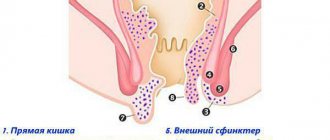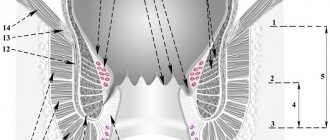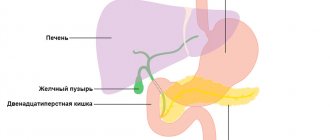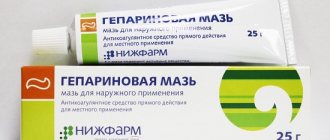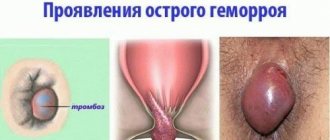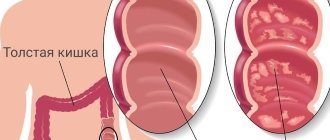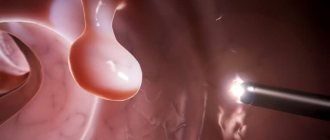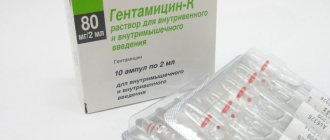Causes of thrombosis in hemorrhoids
Thrombosis of the hemorrhoidal node is a common complication of hemorrhoids, which is associated with impaired blood circulation in the anorectal area, the formation of a blood clot (thrombus) in the cavernous plexuses of the rectum.
The patient feels severe pain in the rectum area, not associated with the process of defecation, and a constant sensation of a foreign body in the anus. According to the ICD, hemorrhoidal thrombosis has code K.64.5
The rectum ampulla is surrounded by venous caverns, which, together with the anal sphincter, prevent the arbitrary release of gases and feces from the anus. These formations are permeated with vessels, which, under the influence of various negative factors, lose their tone. As a result, the blood begins to stagnate, the veins expand and become deformed. This is how hemorrhoidal nodules are formed.
In the process of life, work, and sports, a person’s intra-abdominal pressure changes. Deformed vessels are not able to cope with it, so the body turns on “protection”, turning stagnant blood into a blood clot. This is the main cause of thrombosis or thrombophlebitis. Contribute to the development of pathology:
- hereditary predisposition;
- bad habits;
- alcoholism, diet violations;
- constipation or diarrhea;
- constant lifting of weights;
- physical inactivity;
- "sedentary work;
- chronic inflammation of the pelvic organs;
- pregnancy;
- low temperatures.
Thrombosis of internal hemorrhoids develops due to pinching of the cones by the sphincter and occurs very rarely
.
Detection methods
Thrombosis can be determined by a medical specialist through diagnosis, but the patient himself must be attentive to his health (especially for the external type of the disease).
Diagnostic methods:
- visual examination (on your own, with the help of loved ones or with the participation of a doctor);
- digital examination of the rectum (done by a specialist);
- use of modern equipment (anoscope, rectoscope, etc.).
Externally, the nodes look like violet-bluish formations, and when pressed on, their volume may decrease. There may be black inclusions – necrotic areas.
After palpation, it is possible to see traces of blood on medical gloves; formations inside the rectum bleed; upon contact with them, the patient complains of severe pain.
Examination of the rectum and anus using special devices can give the most complete picture of the disease and make a diagnosis of thrombosis.
What is the danger of thrombophlebitis of hemorrhoidal veins
In ordinary life, it is possible to injure the wall of the external hemorrhoid when performing hygiene procedures. After this, with normal blood clotting, thrombosis of the blood vessels occurs, which stops the bleeding. Then, the blood clot resolves without any consequences. But if thrombus formation occurs without injury, against the background of negative changes in the circulatory system, a condition that is dangerous to human life arises:
- acute thrombosis requiring urgent surgery;
- sepsis;
- atypia with transformation into cancer;
- detachment of a blood clot from the cavity wall with transfer through the bloodstream to the coronaries, cerebral vessels, pulmonary artery and the development of stroke, heart attack, pulmonary embolism.
Each condition can be fatal. That is why any person suffering from hemorrhoidal disease must consult a doctor.
Types and degrees of disease
The localization of hemorrhoids with thrombosis is the basis of the classification:
- outer;
- interior;
- combined thrombophlebitis of the node.
The severity of symptoms determines the severity of the pathology:
- first - there are no signs of inflammation of the caverns;
- second - thrombosed nodes of any location give the first symptoms: pain, bruising, swelling of the anus
; - third - inflammation affects nearby tissues, complications arise.
According to the severity of the process, hemorrhoidal thrombosis is distinguished between acute (complicated) and chronic (recurrent).
Varieties
Depending on the location of the lump, we can talk about the appearance of internal, external, or combined thrombosis.
The presence of thrombosis inside is characterized by inflammation of the hemorrhoidal node (one or more), and there are frequent cases of thrombosed hemorrhoidal node falling out, which sometimes complicates examination and treatment.
The appearance of an external complication is associated with external nodes; this process often takes place with virtually no pain, with the exception of unpleasant moments associated with swelling near the anus.
Thrombosis of the combined type is not so common, because cases of inflammation of the hemorrhoid both externally and internally are rare.
Clinical symptoms
The photo shows live external thrombosis of a hemorrhoid.
The very first symptom or sign of hemorrhoidal thrombosis is sudden pain that is accompanied by discomfort in the anorectal area.
The nodule formed as a result of thrombosis begins to grow, and the person feels a foreign body in the anus. The nature of the pain changes. If with hemorrhoids of any localization the pain is caused by the act of defecation, then a blood clot in the venous plexus causes constant pain that is not associated with anything.
The clinical picture develops gradually and corresponds to the stages of pathology, which are presented in the table.
Diagnosis of thrombosis
The examination is carried out in the most comfortable position for the patient!
A comprehensive diagnosis is carried out for a more complete and in-depth study, allowing you to see the full clinical picture of the disease:
- Digital examination of the rectum
- Hardware diagnostics Videoanoscopy
- Video sigmoidoscopy
Depending on the clinical symptoms and complaints (for example, a complaint that the anus is itchy), the proctologist may prescribe additional examination methods.
Possible complications
The progression of thrombophlebitis of hemorrhoids causes a number of complications requiring medical intervention:
- bleeding;
- varicose veins of the anal veins;
- abscess of soft tissues of the perianal area;
- necrosis of thrombosed nodes with symptoms of severe intoxication;
- addition of a secondary infection;
- anal dermatitis;
- postoperative fistulas, suture dehiscence, narrowing of the anus.
Any of the complications requires prompt attention to a specialist.
Diagnostics
As a rule, an accurate diagnosis of hemorrhoidal vein thrombosis is made quickly, based on a visual examination of the anorectal area, a characteristic clinic. Thrombosis of the external hemorrhoid is localized under the pectineal line; it is inflamed, cyanotic, and painful. Internal - accompanied by a pronounced furrow between the prolapsed node and the swollen skin of the anorectal area. If there is no prolapse, a revision of the rectum is needed, which is carried out under local anesthesia due to unbearable pain.
Laboratory and instrumental methods are used:
- OAC, OAM – assessment of the patient’s general condition;
- coagulogram, electrocoagulography, detailed hemostasiogram - determine signs of hemostasis impairment;
- rectoscopy - for severe pain with suspected cancer, strangulation of a polyp, paraproctitis in the acute phase.
Without an accurate diagnosis, it is impossible to prescribe adequate therapy.
Treatment of hemorrhoids complicated by thrombosis
Conservative therapy is a temporary measure to eliminate symptoms. It is used in our clinic if the patient is unable to perform the operation (for example, he is about to fly on an airplane).
A much more effective method is an operation to disarterize hemorrhoids using the AMI HAL-Doppler II device. Desarterization is combined with excision of the thrombosed node.
Why is it worth performing disarterization surgery at MedicCity?
- We choose surgery as the most effective way to solve the problem. You will forget about hemorrhoids!
- After surgery in the early stages (stages 1 and 2), the risk of relapse is zero. At later stages (stages 2 and 3) - no more than 1.5%.
- It is performed without pain, under intravenous sedation (medicated sleep) and local anesthesia;
- Maximum gentle, low-traumatic;
- It is performed on an outpatient basis, in 1 day, and does not require hospitalization. You can return home the same day.
Rustam Abdullaev, a surgeon and proctologist at MedicCity, talks about the technique of disarterization of hemorrhoids under ultrasound control in the Doctors program (TVC).
Recommendations after surgery
Modern methods of treatment
How exactly to treat hemorrhoidal thrombosis depends on the location of the pathological process, the stage of the disease, and the degree of severity. A distinction is made between drug therapy and surgical intervention. Sometimes they are combined. Folk recipes are used as background.
Indications for prescribing medications are:
- acute process;
- prevention of complications;
- relapse prevention;
- preparation for surgery;
- postoperative rehabilitation.
Conservative therapy for hemorrhoidal thrombosis is carried out at home: preference is given to tablets, suppositories, ointments, lotions and compresses.
Conservative methods of treating thrombosed hemorrhoids do not provide a long-term therapeutic effect, and the risk of relapse is high.
Treatment of hemorrhoidal thrombosis, surgery and medications
The duration of treatment depends on the patient’s condition, the presence of concomitant pathologies, age and stage of the disease. Individual treatment is selected for each patient. Treatment with conservative methods is mandatory. However, the use of medications provides only a temporary effect. If the blood clots are not eliminated completely, a relapse of the disease with complications will soon develop.
A satisfactory result will be obtained only if the patient attends surgery. Therapeutic techniques eliminate painful symptoms, but do not affect the treatment of the disease. Surgical intervention, in turn, acts directly on the site of the disease and reduces the frequency of relapses.
Pills
They are used as drugs that have a systemic effect, do not irritate the intestines, to dissolve blood clots, normalize microcirculation, and relieve inflammation.
Venotonics
Systemic drugs that increase vascular tone, stimulate the outflow of blood from hemorrhoids, and relieve congestion.
Detralex
Detralex tablets. They are the drug of choice. They act actively at the first signs of the disease. Particularly effective for external hemorrhoids.
Phlebodia 600
Phlebodia 600 capsules. The drug tones the veins, makes them stronger, and balances venous blood flow.
Troxevasin
Troxevasin tablets. Venotonic with antioxidant, anti-inflammatory, angioprotective properties.
Non-steroidal anti-inflammatory drugs (NSAIDs)
Drugs of the NSAID group are indicated for relieving inflammation during thrombosis of external and internal hemorrhoids, and for relieving pain. They are used with caution because they can thin the blood and, in case of overdose, cause bleeding of hemorrhoids.
Diclofenac
Diclofenac tablets. The drug quickly and effectively relieves pain, inflammation, and promotes the resorption of blood clots.
Nise
Nise tablets. Anti-inflammatory, analgesic mono-drug. Prostaglandin synthesis corrector.
Postoperative period
In the first week after thrombectomy of hemorrhoids, the patient is recommended a gentle diet in order to maximize ease of bowel movements, as well as enhanced perineal hygiene with the application of sterile dressings to the suture area. If inflammation is present, it may be necessary to treat the wound with medications in the form of solutions or ointments.
To avoid postoperative complications, the patient is recommended:
- avoid excessive straining or heavy lifting;
- eat mainly vegetable dishes;
- increase water consumption to two liters per day;
- take medications to increase vascular tone and reduce thrombosis;
- bandage daily and maintain perineal hygiene.
Candles and ointments
Thrombosis of the external hemorrhoid is most effectively treated with ointments or suppositories. The goal of therapy is to relieve pain and dissolve blood clots. It is often combined with tablet medications.
Anticoagulants
The most effective ointments, which are used in the treatment of both external and internal thrombosed hemorrhoids, prevent blood clotting.
Heparin ointment
Heparin ointment. An inexpensive, effective remedy that acts on the blood coagulation system, prevents thrombosis of nodes, has a local anesthetic and anti-inflammatory effect, increases the tone of the veins, and stimulates tissue regeneration.
Gepatrombin G
Suppositories and ointment Gepatrombin G. The most effective remedy for internal hemorrhoids, resolves already formed blood clots and prevents the formation of new ones.
Surgical treatment methods
Radical therapy for hemorrhoidal thrombosis is possible in the third degree of severity of the disease. The operation can be performed for vital reasons, immediately (bleeding, pinched node) or after the severity of the process has been removed. There are two types of surgery: thrombectomy or hemorrhoidectomy according to Milligan-Morgan. Minimally invasive techniques are not used, since thrombosis is a direct contraindication to them.
Thrombectomy
Thrombectomy is used to treat thrombosis of the external hemorrhoid without complications.
The essence of the operation is to open a hemorrhoidal cone with a blood clot, remove the blood clot and leave the wound open for independent healing. Read more: thrombectomy of hemorrhoids, what it is, the likelihood of relapse
An indisputable advantage is the possibility of performing the procedure in pregnant women. In addition, the method is minimally traumatic and wound healing occurs quickly. The downside is the use of thrombectomy only for thrombosis of external hemorrhoids, as well as the risk of relapse due to injury to the walls of the node at the time of surgery.
Hemorrhoidectomy
{banner_banstat9}
The operation of hemorrhoidectomy is applicable for acute hemorrhoidal thrombosis, complicated by bleeding, strangulation of the node and in a planned manner. The essence is complete excision of a hemorrhoid of any location. The easiest way is to cut off the affected node from the blood vessels at the base of the leg - this is the Milligan-Morgan method. The operation is performed under general or epidural anesthesia. The completion of the operation can be different:
- without stitching the excised tissue - open hemorrhoidectomy;
- with the wound tightly sutured - a closed version of the Milligan-Morgan operation;
- submucosal removal.
Efficiency reaches 98%, the risk of relapse is reduced to zero. In case of inflammation of the perirectal tissue, additional manipulations may be required, for example, drainage of the anorectal area to reduce the inflammatory infiltrate.
How is the operation performed?
The procedure can be performed in a gynecological-style chair or on a couch and takes a few minutes. First, doctors give an anesthetic injection that “freezes” the tissue, just like in a dentist’s office. Therefore, the patient is conscious, but does not feel pain.
The surgical intervention takes several minutes and involves three manipulations: ___• opening the affected node (small incision), ___• removing the blood clot, ___• stopping the bleeding (the wound can be sutured, but more often it is not sutured)
After the procedure you can go home.
The exception is those cases of thrombosis when severe complications occur (gangrene of the node, paraproctitis, severe bleeding) that require hospitalization.
Folk remedies
{banner_banstat10}
How quickly hemorrhoidal thrombosis goes away depends on how well the treatment package is chosen. One of the components of combination therapy for thrombosed hemorrhoids is folk recipes. But it is important to understand that it is impossible to cure thrombophlebitis of the rectal veins only with folk remedies. Moreover, failure to consult a doctor can have unpredictable consequences.
Baths
For thrombosis, the most popular methods of alternative medicine are sitz baths with medicinal herbs:
- baths with a decoction of water pepper, which contains tannins, rutin, quercetin, and organic acids. A handful of herbs is poured into 2 liters of hot water, boiled for a quarter of an hour, left for 20 minutes, filtered, poured into a basin, 0.5 liters of boiling milk is added, sat down so that the hemorrhoids are covered with the solution, the procedure is done at night for a month;
- cold sitz baths from horse chestnut decoction - crush 50 g of branches, pour in a liter of water, simmer for 5 minutes, cool, pour into a basin that already contains 2 liters of cool water, sit for 15 minutes so that the water covers the nodes or irritated anorectum region;
- warm baths from birch leaves - pour a handful of leaves with a liter of boiling water, leave for half an hour, filter, pour into a basin with 2 liters of clean warm water, sit for half an hour so that the anorectal area is covered with the solution;
- sow thistle - the plant is used for thrombosis of the node: a handful of sow thistle is poured into a liter of water and boiled for a minute, then the decoction cools, wrapped in a warm blanket, it is filtered, used for cool baths for 20 minutes, three times a week, for a month;
- sitz bath with aloe juice - juice from several leaves of the plant is dissolved in cool water (2 liters), sit in a basin for 15 minutes so that the thrombosed nodes are covered with the solution (this procedure is effective in the early stages of thrombosis).
Lotions, compresses
Procedures are used to relieve inflammation, painful nodes, and resolve blood clots:
- the easiest way is lotions with strong black tea, which have an astringent effect and contain tannin and tannins;
- disinfect the anorectal area in case of thrombosis using a lotion with a solution of potassium permanganate;
- aloe leaves should be put in the refrigerator for a day (ideally, they should be stored for a week in a dark, cool place), the plant leaf is washed, dried, cut and applied with the sticky side to the node, left until all the juice is absorbed, change the leaf three times/ day during the week;
- horse chestnut flowers are crushed, wrapped in gauze and applied to the site of thrombosis, this relieves pain and inflammation;
- if the thrombosed nodes are injured and begin to heal, then take horse chestnut and rowan flowers in equal parts, add one part of arnica, mix everything, then pour 5 g of the collection with a glass of boiling water, leave for an hour, filter, apply a napkin soaked in this solution to the nodes, for a few minutes. Repeat the action until the pain subsides and bleeding disappears;
- prepare a decoction of quince flowers, pomegranate, blackberry leaves, strawberries - they all have an astringent effect in the form of lotions;
- Compresses made from raw potatoes are effective: the tuber is grated, wrapped in gauze, and applied to the site with the blood clot for half an hour;
- mint, oak and alder bark, chamomile, cucumber lashes, grape leaves are mixed in equal proportions, a concentrated decoction is prepared, sterile gauze is soaked in the medicine, and applied to thrombosed hemorrhoids.
If we are talking about rectal thrombosis, instead of napkins or gauze, use cotton swabs, which are soaked in decoctions and administered rectally.
Decoctions can be drunk internally, herbs are brewed like tea and have a good effect on the gastrointestinal tract.
Homemade candles
The most effective are suppositories made from raw potatoes, which are cut from the middle of the tuber, lubricated with olive oil, and administered rectally for pain in the first stages of hemorrhoidal thrombosis.
According to patient reviews, suppositories have a mild, quick pain-relieving effect. Doctors prefer suppositories made from natural propolis. You can add pine resin to it, heat the mixture in a water bath, then add a few drops of natural oil. Cool. Suppositories are made in small sizes and carefully inserted into the rectum, which helps dissolve blood clots, normalizes blood circulation, relieves inflammation, pain, swelling, and heals damaged tissue. Propolis suppositories are antioxidants and antiseptics.
In addition, you can use:
- ice suppositories with a decoction of medicinal herbs are an effective pain reliever and stops the worm (minus – temporary effect);
- a candle made of beets or garlic, inserted into the rectum at night, relieves inflammation during thrombosis, disinfects the anorectal area;
- candles made from honey in vegetable oil, frozen in the refrigerator, have analgesic, anti-inflammatory, and disinfectant properties.
Ointments
Therapy for hemorrhoidal thrombosis is carried out using homemade ointments that relieve pain, inflammation, stimulate blood flow in the anorectal area, and wound healing:
- ointment with propolis - most loved by patients and doctors; to prepare it, animal fat is heated to room temperature and propolis is added in equal parts, then the mixture is applied to the thrombosed node overnight, and washed off in running water in the morning;
- soft butter is mixed with honey, the mixture is applied in a similar way;
- fresh cabbage is boiled in milk, cooled, crushed together with bran to a homogeneous mass, which is applied to the nodes;
- birch tar is mixed with animal fat in equal proportions and applied to the thrombosed node (tar is a strong allergen, so an allergy test is needed before application);
- tar can be mixed with Vaseline (1:10), infuse the mixture, apply to the nodes after intimate hygiene.
Hirudotherapy is effective for hemorrhoidal thrombus. A leech is planted on each affected node, which sucks out the blood; the node decreases in size, dries out and falls off.
Diet
Nutrition for hemorrhoidal thrombosis is an integral part of the overall complex treatment. The antithrombotic diet has several features:
- at the time of exacerbation of hemorrhoids, patients are limited in the amount of liquid they drink per day: the usual drinking ration is halved;
- Products containing vitamin K and C are prohibited for consumption: tomatoes, currants, all citrus fruits, liver, cabbage increase blood clotting, provoking the formation of more and more blood clots;
- during the period of remission - regular meals, fractional meals, in small portions (palm size), dishes are steamed;
- Smoking and alcohol are strictly prohibited during any period of illness.
Nutrition directly affects the patient’s recovery rate after surgery.
The table shows permitted and prohibited products for everyone who suffers from hemorrhoids of any location with a history of node thrombosis.
Prevention, prognosis
In a person suffering from hemorrhoidal disease, the risk of node thrombosis increases if the following rules are not followed:
- violate nutritional principles, consume alcohol, prohibited foods;
- do not follow the rules of intimate hygiene of the anorectal area after each bowel movement;
- sit a lot, move little;
- lift weights;
- supercool;
- do not control bowel function;
- do not undergo regular medical examinations with monitoring of blood tests for clotting;
- If a pathology is detected, do not immediately consult a doctor for adequate therapy.
The prognosis for thrombosis of an enlarged hemorrhoidal cone is generally favorable, but only with competent and timely therapy. Self-resorption of a blood clot is possible at the first stage of the disease.
However, it is unreasonable to hope for this; this is not the rule, but the exception to it. Therefore, the basis for preventing hemorrhoid thrombosis and maintaining quality of life is a timely visit to a specialist and the implementation of all his recommendations.
Preparation for the procedure
On the eve of planned surgical treatment of hemorrhoids, the following studies are required:
- blood and urine tests;
- Wasserman test;
- fluorography;
- electrocardiogram;
- determination of glucose in blood.
At the same time, before the operation, the dinner should be light; foods that cause flatulence are not allowed. It is also recommended to perform two cleansing enemas a few hours before surgery (interval - about 60 minutes).
